Blog Log: 26 June, 2011
 June 28, 2011
June 28, 2011
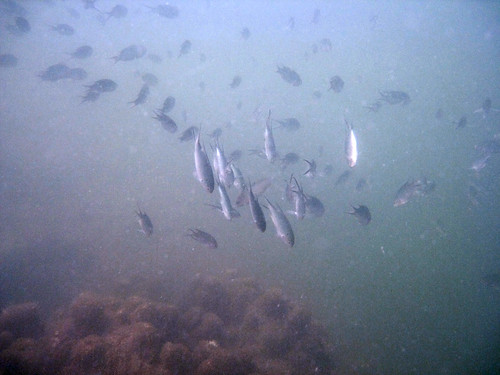
Dark clouds made the divers nervous on Sunday morning as we set out for our monthly dives at Pulau Hantu. As our boat steered into the shallow waters around the island, day time turned into night and the first few raindrops fell as the divers began to rig up. Moments after the first divers jumped into the water, the rain dissipated and the clouds dispersed. So goes the fickle weather. Lucky us. Sometimes when the weather gets too horrendous, we may have to all of the dive. I’m glad we didn’t have to do that today. Above: Damsel fish school around reefs, seemingly feeding as they dived purposefully and swirled about in the water in small groups.

As my dive buddy, Alex, and I descended, we practically “fell” onto a little cuttlefish that was perfectly camouflaged with some debris that was resting on the seabed. It took Alex a few seconds to figure out what I was pointing at, and the cuttlefish remained still, convinced that its strategy was working. But as soon as Alex approached with his camera, the cuttlefish shot away in a single jet of water! Perhaps there was something on his camera that made the cuttlefish feel threatened, or perhaps it was how he approached the critter. When diving, we always try not to be intrusive, taking pictures and videos as they go about their business, not disturbing their feeding or hiding, but sometimes it can be a little tricky doing so – especially when the animals are as smart as cuttlefish.
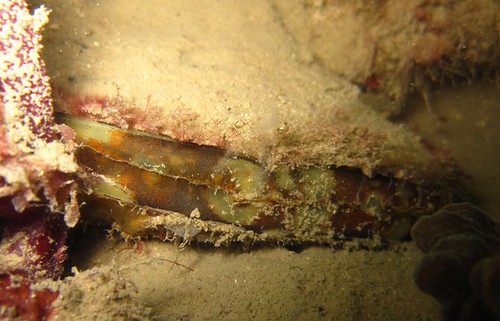
Hantu Blog volunteer, Cindy Tan, found a gorgeous pen shell, a usually overlooked reef organism. Overlooked by divers that is, as many people enjoy eating these clams with razor sharp edges to its shell. I even know of people who collect these shells perhaps for use in art works.
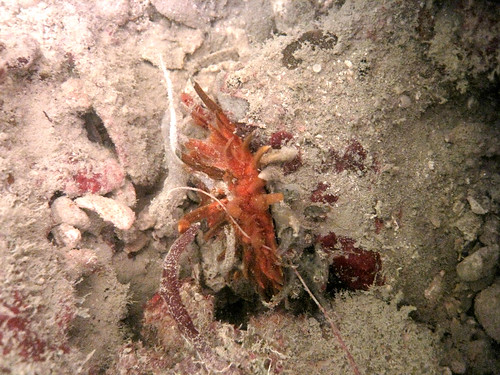
Here’s another clam, but this one isn’t razor sharp, it’s just very spiney. The shell us actually white in colour but this one is encrusted. This shell is also collected for use in the design of jewellery. One part of its shell is fastened to the rock substrate, so its not a free living clam.

Something else Cindy spotted was this gorgeous flatworm. She said that this too was very well camouflaged.
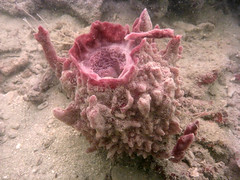
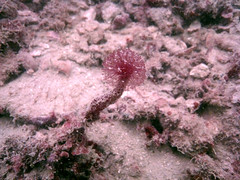
Despite the silt that blankets much of the reef and seabed, we still see some nice large sponges like his pink-coloured Barrel sponge, and this little Red maiden fan ( Oceanapia sagittaria) that is said to be “Singapore’s prettiest sponge”.

Cindy found this Red swimmer crab that had half its body into a hole. Perhaps it was cautious of the attention it was getting and wanted to position itself for a quick get away if that became necessary!
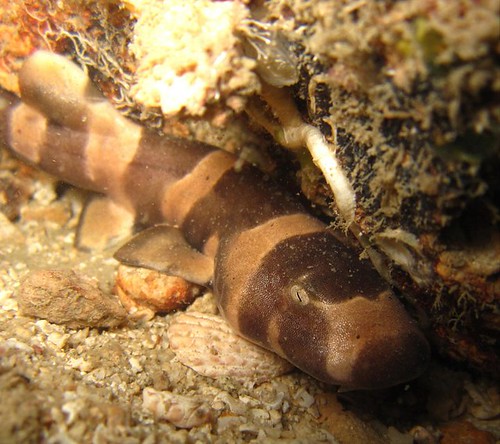
Then, Cindy and her group came across an even more exhilarating find – a palm-sized Bamboo shark also known as a Long-tailed carpet shark. Last month, Cindy also encountered another one of these adorable babies but it was a larger one than this. It’s good to know that the sharks are breeding, but they have a tough life ahead of them – apart from out smarting predators on the reef, these young sharks, which are often actively hunting at night, have to also be aware of the fishing lines of many fishermen who go out to the southern islands at night. The young sharks will also have to evade the occasional bubu cage that is laid to rest on the reef slopes.
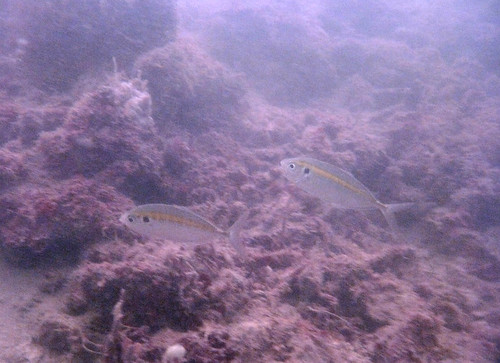
Although the reef was comparatively “quiet” this weekend, all the guides agreed that there were plenty of fish out. I managed to get a photograph of these super fast swimming Yellowstripe Scad or Kuning (also known as the nasi lemak fish!) There were also Yellow-tail barracuda, Yellow-spot rabbitfish, an Oriental sweetlips and a Golden snapper that was about 4ft long, which gave me a fright as it dashed right in front of me!
On the shallow end of the reef there were lots of gorgeous corals.
I have seen them dozens of times but I still enjoy observing these Tomato clown anemonefish. They are so lively! Sometimes they can be hard to photograph when they just dive into the anemone and disappear, or they can go under the anemone. On the right are some Five-lined cardinalfish that have gathered near a Diadema sea urchin.
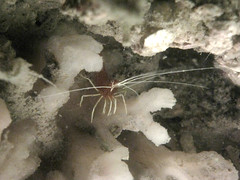
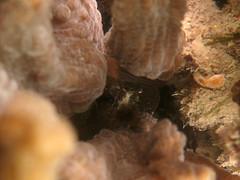
There were also some shrimps on the reef, both of them midden into little nooks on the reef – one in a sponge, and another in the branches of a coral. I’d hide deep in a coral too with all the hungry fish that were about on the reef today!
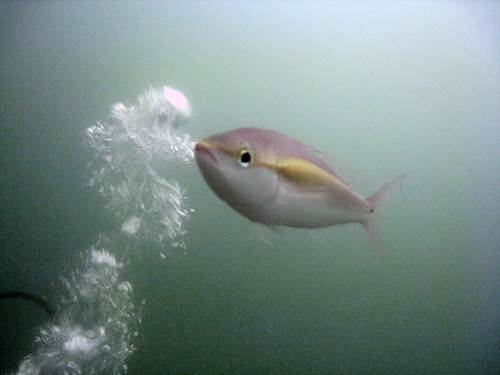
While I was photographing the shrimp, a small school of opportunistic Butterfly whiptails swarmed around my buddy and I.I’d observed these fish spitting jets of water at onto the sediment on the seabed, and picking out morsels of food that would be blown into the water. I guess they came close to us because they expected we’d kick up some sediment for them to pick out from, and when we didn’t, this particular one in the photograph decided to get a bite anyway from my fingers! As I had my face behind the camera, this whiptail bit my pinkie twice and tugged at it for a few seconds! Thank goodness it didn’t have teeth like a barracuda! This individual was also very curious and active, darting into and biting the bubbles we were exhaling. It was very entertaining to watch, and they remain my favourite fish in Hantu.
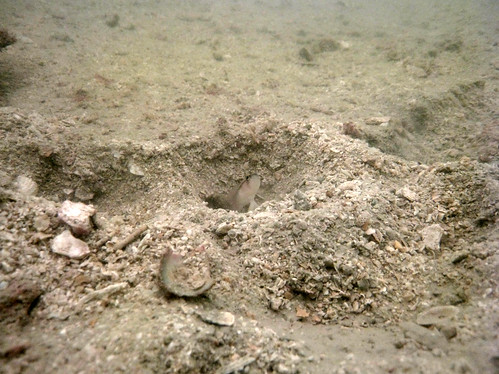
A goby peeks out of the entrance of its burrow. There are plenty of them and their shrimp living in the sand and silt around Hantu’s reefs.
There were not too many sea slugs out today, just this Black-margined nudibranch (left) and the Oreo-cookie nudibranch. Both of them have such gorgeous gills that sway back and forth in the current.
To view more pictures from this dive, visit the Hantu Blog Gallery.
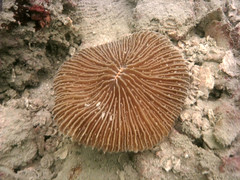
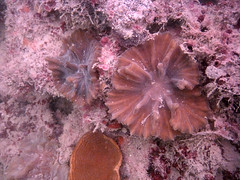
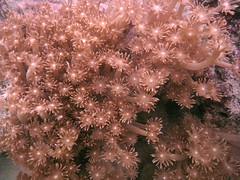
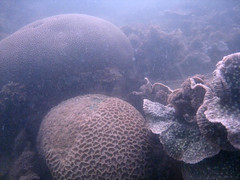

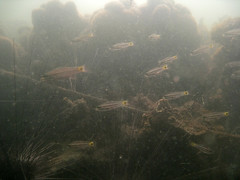
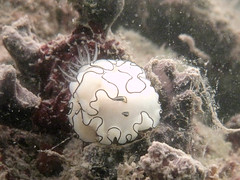
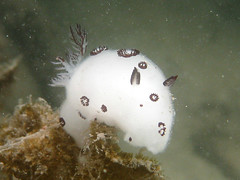
 Posted in
Posted in 



 content rss
content rss
COMMENTS